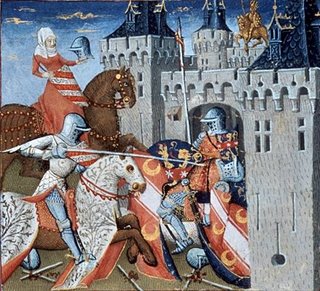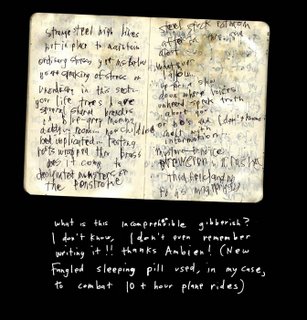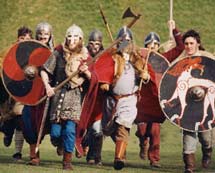

My favorite book of Prof. Cohen's is
Medieval Identity Machines [2nd favorite--
Of Giants: Sex, Monsters, and the Middle Ages]. When I had my students at Southern Illinois University [enrolled in my
Masculinity, Violence, and the Medieval Romance course] read the chapters "Chevalrie" and "Masoch/Lancelotism," let's just say they were, um . . . kind of blown away. Those who weren't blown away were really, really discomfited [which I always think is a good thing]; i.e., they were "disturbed." I guess I always assumed that it has been broadly read [and taught?], and when JJC mentioned in a blog posting not very long ago that it was his least reviewed [and by implication, least understood?] book, I thought . . . whaaaaaa? But then again, why am I surprised? In any case, I thought I would share here a short paper I delivered last fall at Notre Dame that was greatly influenced by
MIM [and to a certain extent, also, by
Of Giants], to show how JJC's thought impacted my teaching of Chretien de Troyes and also helped me connect that [reading/thinking/teaching] experience with current events in the war in Iraq.
honour desires the body's pain: The Posthuman Circuits of Chivalric Desire in Chretien's
Yvain and the Iraq War
In the famous medieval story of the renowned knight and doomed lover Tristan, retold by Gottfried von Strassburg in the early thirteenth century, when Tristan is seventeen his uncle, King Mark of Cornwall, asks him how he would feel about being knighted. Tristan responds that he “would love to be a knight, to train my idle youth and wean it to worldly honours,” but he also reproaches himself bitterly for not having yet exercised his “untried youth”—by which he means, he has never engaged in combat—and he tells Mark and the rest of Mark’s court that he has “read that honour desires the body’s pain, and comfort is death to honour.”[1] Indeed, it could be argued that, although the term “chivalry,” in the Middle Ages, denoted a whole set of fluctuating and highly-localized yet also transcultural social practices and quasi-religious beliefs, that physical violence—most often in the form of battlefield or single combat—represented the primary experience through which aristocratic men, fictional or otherwise, proved and shaped their knightliness, and also their masculinity. In his book,
Medieval Identity Machines, Jeffrey Cohen has written that medieval chivalry represented a “rigorous training of subjectivity and body,” and further, the word “chivalry” itself
“denotes both a powerful cultural fantasy and a catalyst to the formation of a specific kind of European Christian aristocratic male subject. Chivalry aroused and then shaped the desires of an elite fighting class, delineating the contours of socially acceptable expressions of force and passion. Intimately connected in its genesis to the necessity of producing a sufficient supply of men capable of keeping the nation safe from attack and of furthering imperial interests abroad, chivalry aimed to create a body at once deadly in its sanctioned violence and docile in its comportment at home.”[2]
One result of all this was the creation of a tension between acceptable social conduct and sexual and violent excesses that “formed chivalry’s conflicted heart,” and to make matters worse, the “impossible perfection of knighthood was [always] limned by nightmares of its own self-dissolution.”[3]
Nothing was more instrumental for the maintenance of chivalric identity, I would argue, than medieval romance, a genre well-suited to solicit the passions of its young, male readers with its tales of lone adventuring, jousting with the boys, killing giants, rescuing virgins, and fighting in large-scale wars. As Tristan, a character in a romance, states in his own story, he has read that “honour desires the body’s pain.” This point is worth re-emphasizing: Tristan, himself a fictional character in a fictional romance, is familiar with the very literature through which he has been created as a heroic figure. As Johan Huizinga once wrote of medieval knights, “They wear the mask of Lancelot and Tristan. It is an amazing self-deception.”[4] But it is a self-deception absolutely necessary in martial culture, for, as Cohen has also written, “in order for battles to be fought and won, young men must be made willing to sacrifice their own bodies to ensure the endurance of the structure of power that their activity undergirds.”[5] Perhaps ironically, the knight is made to believe, through the genre of romance and other politico-ideological means, that his assumption of a chivalric identity—at the moment, let’s say, he decides to take up arms—is a freely-willed form of self-fashioning, whereas in reality, he lives his life exactly the way he has been socially conditioned to live it. Chivalry appears, on the surface, to offer a type of freedom—the freedom to leave home, for example, and the freedom to create one’s self through various acts of personal
techne, while in actuality, the community of chivalry is the very antithesis of freedom. The function of medieval romances, such as Strassburg’s
Tristan, Wolfram von Eschenbach’s
Parzival, and Chretien de Troyes’
Arthurian Romances, according to Cohen, is to provide the “hypnotic glimmer” and “cannibal poetics” of the chivalric, heroic self, and to offer men “in mythic form everything that they [actually] cannot have: freedom of movement, freedom of desire, freedom from the constraints of history and time.”[6] And what each potential knight-soldier is finally drawn into is not a literary romance or heroic life, but the defining, Freudian romance of history itself, a romance, according to Cohen, “written by a father, with a father’s wished-for ending. The possibility of rebellion is itself sentenced to death, and the good son[, once sacrificed] joins the body of patriarchs. The story is [always] set to repeat.”[7] And I would add that chivalry is ultimately a form of ghost-writing upon the skin and body of the knight: the instrument of his legibility is the sword of his enemy. And the knight’s blood, spilled on the ground, is the sum of his parts and meaning.
If we were to number all the leaves of all the medieval manuscripts that contained romance stories, they would fill Chartres Cathedral to the rafters and then some, and I can not even begin to do justice here to the barest description of the entire corpus or even to the most spare description of the shared features of the generic plots, but what I would like to do is briefly focus on one particular romance by the twelfth-century French author Chretien de Troyes, “The Knight with the Lion” (typically referred to as the story of Yvain), and even more particularly, on a portion of that story that involves Yvain’s association and friendship with a lion, whom he rescues from the clutches of a dragon after determining that “he would take the lion’s part, since a venomous and wicked creature deserves only harm: the dragon was venomous and fire leapt from its mouth because it was so full of wickedness.”[8] And further, “Pity summoned and urged him to aid and succour the noble and honorable beast.”[9] [And it goes without saying that the dragon, historically, is symbolically associated with everything that is not “noble” and masculine: it is feminine, variable in its sexuality, Asiatic, Muslim, chthonic, etc.] After Yvain slays the dragon by hacking it into tiny pieces—a typical day in the park for a medieval knight—the lion is so grateful that, uncharacteristically for a lion, “it stood up on its hind paws, bowed its head, joined its forepaws and extended them towards Yvain, in an act of total submission,”[10] and from that day on the lion never leaves Yvain’s side. In fact, from that point forward in the story Yvain is known only as “One who they say is never without a lion.”[11]
Yvain’s larger story actually begins prior to his encounter with the lion—with his already established renown as one of Arthur’s best knights, as well as a particular adventure he undertakes that leads to his marriage with a woman whose husband he has killed in single combat. But when he meets the lion, Yvain has been wandering by himself through wild terrain and various towns, partly because he broke a promise to his wife to return to her within one year and one day after leaving her shortly after their wedding to go tourneying, which is really “code” for: hang out with the boys, fight, hunt, and kill some things. When one of his wife’s female servants, Lunete, tracks him down and demands back her lady’s ring, since Yvain has broken his promise, he is stunned and Lunete has to forcibly pull the ring from his finger, at which point Yvain literally goes “mad,” strips off all of his clothing, flees into the woods, and lives “in the forest like a madman and a savage.”[12] Clothing and manners are everything in this world, and by entering the forest in this manner, Yvain signifies his complete abdication of everything his aristocratic culture stands for—he is no longer a husband, or even a knight, but is just an animal. Yvain’s real, naked body, no matter how well-trained and “hard,” cannot, by itself, denote knighthood, or any kind of recognizable social identity, since, in the world of chivalry, identity—human and otherwise—is inextricably bound up with what might be called the technology of soldiery: knives, swords, shields, armor, pennants, spurs and horses. Yvain’s entry into the woods—a landscape, moreover, that in chivalric romance always denotes ahistorical and wild time—represents his reduction to a kind of particulate, atomized being. The rest of the story is taken up with his slow progress back to his supposedly more coherent chivalric self, and the lion plays a critical role in the “second act” of Yvain’s self-fashioning as a knight, but also, as a man.
Everywhere he travels, the lion travels with him, and each time Yvain meets an opponent, he tells the lion to sit by and not interfere, yet at just the right moment, the lion always pounces and helps Yvain defeat his enemies. It is clearly important to Yvain to always let his opponents know that he does not require the lion’s help, yet at the same time, when he is overmatched (as he almost always is), the lion flies in, literally, to decide the matter with one deadly swipe of the paw, demonstrating that the chivalric self always “fights clean” and “honorably,” yet also requires, for the decisive moment, a ferocious, unthinking violence. In one extraordinary moment, when the lion believes Yvain is dead after Yvain has accidentally fallen on his own sword in a fit of swooning grief (primarily because he misses his wife so desperately), the lion attempts suicide by propping the same sword against a stone and throwing himself at it. Clearly, the lion lives for and through Yvain, and the two become inseparable halves of the same person. There is a certain fluidity of identity between Yvain and the lion that creates what the French philosophers Gilles Deleuze and Felix Guttari have called an “inhuman circuit”—an “amalgam of force, materiality, and motion” as well as a “network of meaning that decomposes human bodies and intercuts them with the inanimate, [the animal, and] the inhuman.”[13] The lion, of course, is also an allegory for Yvain’s warrior ferocity, which is simultaneously “noble,” like the lion’s bearing (meaning upright, supple, and “hard” in his body, but also “rational” and “moral” in mind), and mortally brutal, like the lion’s sharp claws. Together, they make perfect house guests as well as a beautiful killing machine. Ultimately, it is not discretion that is the better part of valor, but terror—here seen, not only as an object of awe, but also of beauty.
Young medieval men became knights, I would argue, primarily through a process of wounding, and Yvain’s story demonstrates this over and over again, as he and the lion wound and receive wounds together along each step of their adventures. They are even healed together, in order to wound and be wounded again. Typically, knights in medieval romance literature fight under the strain of wounds that would kill “ordinary men,” and phrases like “they fought as the blood rose to their ankles and knees” (as if the battlefields were closed containers) are stock commonplaces. Also typical is the knight who fights too soon after his wounds have only just begun to heal, so that while new wounds are being inflicted, the old wounds simultaneously open and the knight almost drowns in his own blood. The knight’s own blood, shed and re-shed, is the true métier of his existence—the reason he knows he’s really alive, even when dying.
I have been thinking a lot recently about the connections between the ethos of medieval chivalry and the contemporary cultural beliefs of young soldiers, such as Capt. David Rozelle of the Third Armored Calvary Regiment, who became an amputee in June 2003 when an anti-tank mine destroyed part of his right leg and foot. In his recent memoir,
Back In Action: An American Soldier’s Story of Courage, Faith, and Fortitude—itself a species of romance narrative—Rozelle writes of his observation of his injuries shortly after his armored vehicle was blown up (his Humvee actually lifted off the ground and a door and tire were launched 300 meters away):
“My leg was straight and my foot was misshapen and slumped over to the right, lifeless. It wasn’t just limp, but was grotesquely contorted at a severe angle well beyond ninety degrees. . . . Whenever I tried to move it, pain would run up my leg as if someone were shooting me in the foot again and again. The only thing holding my foot onto my body was my boot. The blood was now pouring down the inside of the cargo wall. It was thick and dark, and carried fragments of bone and tissue with it. . . . I worried about being litter-carried in front of my men. Fuck, they never even saw me sleep, and now they would see me carried in like the dead.”[14]
Ultimately, Rozelle was less angry about his injuries (which would result in the amputation of the lower portion of his right leg), than he was about what he termed the loss of his command. In his memoir, he writes, “I was so angry. My command was over, and the war, for me, was over. I had lost everything in an instant.”[15] Somewhat amazingly, Rozelle has become the first amputee soldier in the history of the U.S. Army to successfully petition to be returned to active combat duty, and this petition was partly successful because of the advances that have been made in prosthetic technology. But it was also successful because of Rozelle’s passionate resolve to return to Iraq only as a commander on the ground, where, previously, his code name was “Killer 6,” and the evening before heading out on specific missions, he would rouse his men by shouting, “Killers on the Warpath!”[16] Most relevant to the discussion here is Chapter 4 of Rozelle’s memoir, “My Life as a Texan,” where Rozelle begins by telling his reader that when he thinks about “making a name for myself as a warrior, I think about mythological heroes,”[17] and since many mythological heroes, such as Gilgamesh, Romulus and Remus, had uncertain parentage, and he himself is adopted, Rozelle places himself within the pseudo-historical lineage of heroic myth. The fact that he is originally from Texas where, as he puts it, the colors of the Texas flag represent “bravery, purity, and loyalty,” and everything is bigger than it is anywhere else, provides further evidence of an heroic provenance. He also lets us know in this chapter that, after many conversations with a teacher who was a Vietnam veteran, and who ran a tank division there, he chose to be a “cavalryman” in an armored division, in order to never be one of the “poor bastards” who make up the infantry. In other words, Rozelle sees himself as having chosen the more “elite” military path, one with definite associations with the images and symbolism of the medieval chevalier. Later in the book, in Chapter 15, “Fit for Duty,” we get the story of the grueling physical therapy Rozelle puts himself through in order to place under erasure his official Army status as “Recovering From Traumatic Injury.”[18] In his letter of “Self-Recommendation and Fitness for Duty,” written in January of 2004, Rozelle wrote, “I am already considering my prosthesis an adaptive part of my body, which has no limits on me personally or professionally,”[19] and somewhat extraordinarily, in March of 2004, the Army’s Medical Evaluation Board evaluated Rozelle as “fit for duty.”[20] As Rozelle defines himself primarily as a commander of battle troops, and would clearly have a difficult time existing outside of that identity, he made a decision that he would take nothing less than active command of active combat troops. Setting an unusual historical precedent, the Army granted that request, and in July 2004, Rozelle returned to Iraq. In Rozelle’s statement in his letter that his prosthesis is an “adaptive” part of his body—a part, moreover, he wishes to train for combat—we can see, as Cohen has written, what might be called the chivalric, Deleuzian assemblage of the soldier (part human, part “other than human”), which “necessarily acknowledges that a body is not a singular, essential thing but an inhuman circuit full of unrealized possibility for rethinking identity.”[21] But this is an identity, too, in both Yvain’s and Rozelle’s case, which is a consummate figure of war, a figure that is predicated upon the desire for muscular, yet-also machine-like, proficient might. It tilts toward destruction.
Perhaps we should not view Rozelle through too negative of a lens, for from one perspective, he has demonstrated that his disability does not define nor limit his identity as a soldier, and even as a servant of the state, and his return to Iraq can be viewed, in that sense, as a kind of progressive triumph, both personally and culturally. And while I can see some of the sense in this argument, I do not think we are always aware of the powerful stories and cultural narratives that write our identities upon our bodies. And I am worried, too, about the larger question of whether or not the maiming and deaths of men and women in the war in Iraq is justified by the supposed causes of this war, however we might define them. As Michael Walzer argued convincingly in
Just and Unjust Wars, human society is such that war will likely always be unavoidable, and therefore, it is critical that we insist on war having a moral structure, and we must likewise insist on the vigilant maintenance of that moral structure. As regards Capt. Rozelle and his desire to return to combat duty in Iraq, I keep returning to that moment in Shakespeare’s
Henry V when, the evening before the bloody battle of Agincourt, Henry disguises himself and walks through the camp in order to sound out the morale of his troops. To a small group of soldiers who are clearly worried about the outcome of the next day’s battle, Henry says, “Methinks I could not die anywhere so contented as in the King’s company, his cause being just and his quarrel honorable” (IV.i.126-28), to which one of his soldiers replies, “But if the cause be not good, the King himself hath a heavy reckoning to make, when all those legs and arms and heads, chopped off in battle, shall join together at the latter day and cry all, ‘We died at such a place,’ some swearing, some crying for a surgeon, some upon their wives left poor behind them, some upon the debts they owe, some upon their children rawly left. I am afear’d there are few die well that die in battle; for how can they charitably dispose of anything when blood is their argument?” (IV.i.134-43).[22]
FOOTNOTES
1. Gottfried von Strassburg, Tristan, trans. A.T. Hatto (1960; reprint New York: Penguin Books, 1982), 101.
2. Jeffrey Jerome Cohen, Medieval Identity Machines (Minneapolis: University of Minnesota Press, 2004), 46-47.
3. Ibid., 47.
4. Johan Huizinga, The Waning of the Middle Ages, trans. F. Hopman (1924; reprint New York: St. Martin’s Press, 1984), 69.
5. Jeffrey Jerome Cohen, Of Giants: Sex, Monsters, and the Middle Ages (Minneapolis: University of Minnesota Press, 1999), 82.
6. Cohen, Medieval Identity Machines, 71.
7. Ibid., 85.
8. Chretien de Troyes, “The Knight With the Lion (Yvain),” Arthurian Romances, trans. William W. Kibler (New York: Penguin Books, 1991), 337.
9. Ibid.
10. Ibid.
11. Ibid., 357.
12. Ibid., 330.
13. Cohen, Medieval Identity Machines, 37-38, 76.
14. Rozelle, David, Back in Action: An American Soldier’s Story of Courage, Faith, and Fortitude (Washington, DC: Regnery Publishing, 2005), 143.
15. Ibid., 145.
16. Ibid., 11.
17. Ibid., 31.
18. Ibid., 212.
19. Ibid., 214.
20. Ibid., 218.
21. Cohen, Medieval Identity Machines, 76.
22. Citations of Shakespeare’s Henry V are taken from The Riverside Shakespeare, ed. G. Blakemore Evans (Boston: Houghton Mifflin, 1974).





















